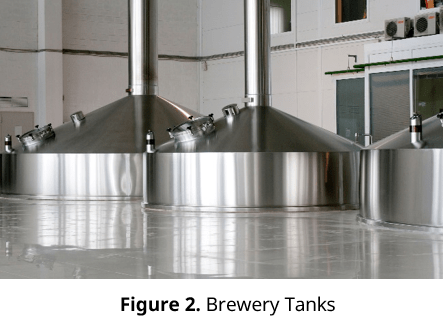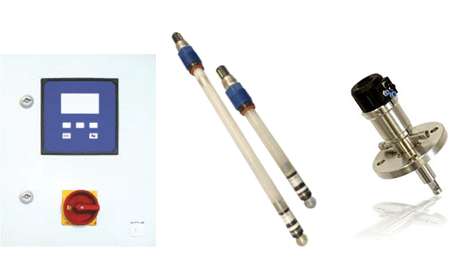The Importance of pH Measurements
Industry: Food & Beverage
Products: pH Liquid Analyzer
Introduction
 The brewery process is the manufacturing process of beer, a fermented beverage with low alcohol content made from various grain types such as wheat, maize, and other grains. It starts from malted barley to form a mash by milling and mixing with hot water. The malt starches are converted to sugars during this process. This sugar-rich water is then strained through the bottom of the mash and called “wort”.
The brewery process is the manufacturing process of beer, a fermented beverage with low alcohol content made from various grain types such as wheat, maize, and other grains. It starts from malted barley to form a mash by milling and mixing with hot water. The malt starches are converted to sugars during this process. This sugar-rich water is then strained through the bottom of the mash and called “wort”.
The wort is then brought to a boil in the brew kettle. For bitterness or aroma, hops are to be added at different times during the boil. Then the wort is cooled and aerated, where brewers yeast is added for fermentation. From the sweet wort, the yeast produces carbon dioxide, alcohol, and other byproducts. This GREEN BEER undergoes maturation after fermentation, followed by filtration and carbonation before being transferred to a holding tank until it is bottled or kegged.
Beer Fermentation
The conversion of fermentable carbohydrates in the wort to alcohol, carbon dioxide, and numerous by-products by the yeast is called fermentation. The aroma, taste, and other characteristics of the beer depends on the effect of these by-products. The composition of the wort, yeast, and conditions play a crucial role in fermentation.

Application Overview
Where and why are the pH Measurements important?
pH determines the acidity or alkalinity of brewing water. A pH 5 is ten times more acidic than a pH 6, 100 times more acidic than a solution at pH 7, and 1,000 times more acidic than a solution at pH 8 because it is a logarithmic scale. The sum of all free acids in the liquid except carbon dioxide is known as titratable total acid. When the pH level is within the setpoint's +/-0.5 pH units, an alarm will be alerted to the user. This indicates that the beverage is too acidic for consumption if the maximum concentration is exceeded.
 pH measurement in wort:
pH measurement in wort:
- The flavor of the final product in beer production is controlled by careful observation of pH and DO values.
- pH measurement during mashing:
- pH values to be maintained during amylase activity is between 5.2 to 5.6. The mash must be made more acidic since the malts usually have higher pH values. This is called souring the malt.
- The enzymes in mashing:
- pH and temperature play a critical role in the activity of enzymes. The yeast activity is maximum when there are an optimum temperature and an optimum pH (figure 4).
Why are the pH measurements important?
The degree of enzyme activity is determined by adjusting the pH value. When brewing beer, pH should be maintained at pH 5 for endopeptidase, which is responsible for decomposing protein in the mash.
Solutions
Frequent cleaning of the sensors is needed due to coating. Online sensor diagnostics detection of pH sensor coating in combination with an automatic wash cycle can save downtime in cleaning, stop unnecessarily repeated calibrations, and improve end-product quality.
Analog and Digital SMART sensors are available. Analog options allow users to interface with a system that has been used historically. SENCOM technology, allows sensors to transmit and receive data when connected to a transmitter/analyzer or any PC. The SMART digital sensors maintain specific measurement and calibration data on an integrated chip in the sensor; providing easy plug and play solutions. Management software optimizes the performance of sensors for enhanced reliability and process safety.
Product Recommendations
 Process Liquid Analyzer:
Process Liquid Analyzer:
2-wire 24VDC Loop Power FLXA202 Analyzer
4-wire AC or DC FLXA402 Analyzer
pH Sensor Selection:
There are a couple of different options available depending on installation location and desired cleaning method.
Option #1: Yokogawa sensor SC21C-AGC55 utilizes a flowing reference system with a ceramic junction. The flow of electrolyte through the junction, while small, remains the safest way to prevent clogging and to protect the internal reference against poisoning and diffusion. The sensor can be paired with an online spray nozzle to automate cleaning.

Option #2: SC25V with automatic cleaning
 The Yokogawa SC25V pH sensor can be combined with the retractable holder EXAtrac RF20 (Extract 810 and 820) for installation where a sensor has to be removed without interruptions or shutdowns in processes where frequent cleaning is of vital importance for accurate pH measurements. The RF20C (Extract 810 and 820) for installation where a sensor has to be removed without interruptions or shutdowns in processes where frequent cleaning is of vital importance for accurate pH measurements. The RF20C (EXmatic 460) control unit provides full and automatic control of the measuring- and cleaning cycles.
The Yokogawa SC25V pH sensor can be combined with the retractable holder EXAtrac RF20 (Extract 810 and 820) for installation where a sensor has to be removed without interruptions or shutdowns in processes where frequent cleaning is of vital importance for accurate pH measurements. The RF20C (Extract 810 and 820) for installation where a sensor has to be removed without interruptions or shutdowns in processes where frequent cleaning is of vital importance for accurate pH measurements. The RF20C (EXmatic 460) control unit provides full and automatic control of the measuring- and cleaning cycles.
Industries
-
Food & Beverage
The food and beverage industry must produce safe, high-quality foods and beverages for consumers. In addition to quality control, the manufacturing processes include many challenges such as managing ingredients, improving efficiency and handling global environmental issues. Yokogawa leverages its decades of technological expertise to help customers build and operate the ideal factory.
Related Products & Solutions
-
12mm pH Sensor SC25V
The SC25V is a pH sensor in a 12 mm design that includes an integral temperature element and a Liquid earth electrode.
-
2-Wire Transmitter/Analyzer FLXA202
- FLEXA™ series analyzers FLXA202
- Continuous on-line industrial measurements
- Most flexible two-wire analyzer available
-
4-Wire SENCOM™ SMART Sensor Platform
SENCOM™ 4.0 Platform technology allows pH/ORP, resistivity/conductivity sensors to transmit and receive data when connected to FLXA402 analyzer or to any PC/tablet with Mobile Field Device Management (FieldMate) installed.
-
All-in-One pH/ORP Sensor Series FU20 and FU24
The FU20 and FU24, all-in-one pH and ORP, sensors show how Yokogawa applies the motto "Simple is best" to sensor technology.
-
Digital SMART SENCOM™ Adapter, SA11
Reusable SMART adapter, requiring only the analog sensor to be disposed of when it reaches the end of its lifetime. With the SENCOM 4.0 platform, Yokogawa delivers reduced costs and waste while contributing to its long-term business goals of a sustainable future for all.
-
Multi Channel 4-Wire Analyzer FLXA402
The FLEXA™ series analyzers are modular-designed analyzers used for continuous online measurements in industrial installations. They offer single or multi-sensor measurement.
-
pH and ORP Analyzers
pH and ORP meters, analyzers and transmitters are used for continuous process monitoring of pH and ORP to ensure water/product quality, monitor effluent discharge, batch neutralization, pulp stock, scrubbers, cooling towers, chemical, water/wastewater treatment and many other applications.
-
SENCOM™ SMART Digital Sensors
- SENCOM™ SMART Digital Sensors
- Maintain specific measurement/calibration data on integrated chip
- Data exchanged between sensor and process transmitter or PC using data management software like SPS24
Have Questions?
Contact a Yokogawa Expert to learn how we can help you solve your challenges.